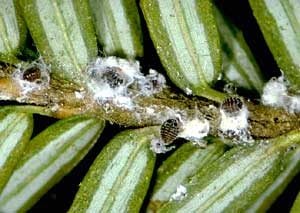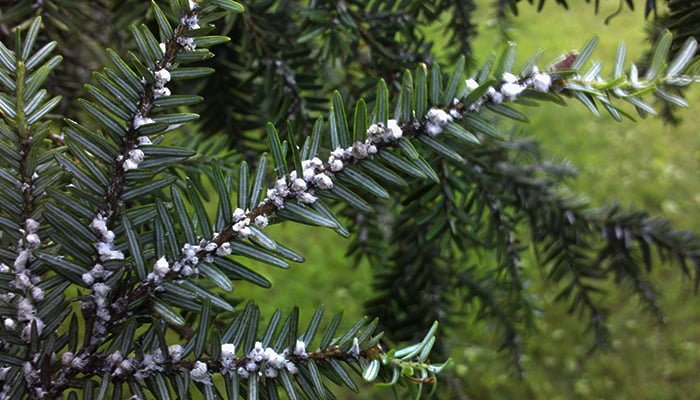Hemlock trees are not only an important part of the natural forest and an essential resource for the timber industry, but they are also a great ornamental addition to residential landscapes. The small aphid-like pests called Hemlock Woolly Adelgids are an invasive species that are a danger to hemlock trees. Horticultural oil spraying is often used as a treatment and management method for an affected hemlock tree.
 The Hemlock Woolly Adelgid is brown to red in color, about 1/32 inches long, and oval-shaped. If you have noticed cotton-like balls on your hemlock trees, this is a sign that the hemlock woolly may be in your backyard.
The Hemlock Woolly Adelgid is brown to red in color, about 1/32 inches long, and oval-shaped. If you have noticed cotton-like balls on your hemlock trees, this is a sign that the hemlock woolly may be in your backyard.
The Hemlock Woolly Adelgid damages hemlock trees by feeding on the tree’s stored starches. This disrupts the flow of nutrients to the tree’s twigs and results in dried up needles and branches. Heavy infestation can kill trees in as little as two years. These damages usually begin from the bottom of the tree and spread upward.
Signs you may have an infestation:
- White woolly masses, about one-quarter the size of a cotton swab, on the underside of branches at the base of needles
- Premature needle drop
- Gray-tinted foliage and damage to needles and branches
- Branch dieback and general loss of vigor
Treatment:
- Hemlock forests are affected greatly because it is very difficult to accomplish complete coverage using aerial treatments, because the masses form on the underside of branches.
- In a landscape setting, when proper technique and equipment is used, the treatment is much more effective.
- As soon as adelgids, mites, or scales are found on your hemlock tree, it should be treated.
- The immature phase of the woolly adelgid’s life is their most vulnerable.
- The immatures remain dormant until mid-October when they come out of dormancy and resume feeding.
- Horticultural oil application is a very effective method for treating the Hemlock Woolly Adelgid.
- It is important to completely cover the top and bottom of the needles and branches.
- If temperatures are above 90 degrees and/or humidity reaches above 90%, this is not an ideal time to use the horticultural oil.
- Summer oils (1% horticultural oils) are most effective when used between August and September.
- Heavier oils (referred to as dormant oils) are used beginning in late fall (during the dormant months) when leaves are falling form trees.
- Heavier horticultural oils are usually applied at a rate of 3-5%.
- It is important not to spray horticultural oil on cold days. The temperature must be at least 45 degrees F.
- Horticultural oil application kills all life stages of the Hemlock Woolly Adelgid, including the eggs; while other treatment methods are not often effective during the egg stage.
- Integrated pest management is the most effective way to control the Hemlock Woolly Adelgid, because it combines short-term protection with a long-term solution.
The Hemlock Woolly Adelgid can be effectively controlled in your home’s landscape if monitored and treated correctly. It is most manageable when found and treated early. It is important to treat the pest during its most vulnerable stages and to use a lighter horticultural oil in summer, and the heavier dormant oils before growth begins again/during the dormant months. Proper application is challenging, and because of this, it is important to hire a certified and trained arborist to apply the oils correctly and manage the pest effectively. The professionals at Red Cedar can help implement an integrated pest management plan that will be most effective in proactively treating and managing your hemlocks. Contact us today for your free consultation!


